WILD CAMPING IN LOFOTEN
Are you planning a camping trip to Lofoten and wondering what the rules for wild camping in Lofoten are?
Thanks to Allemansretten, also known as the “right to roam,” wild camping is technically allowed in Norway.
However, overtourism has led to environmental damage in some areas, prompting local authorities in Lofoten to introduce additional restrictions. In fact, the traditional allemansretten (right to roam) is now being questioned by both officials and locals — especially when it comes to pitching tents or sleeping in vehicles along roads and rest stops. Many locals are frustrated and openly calling for stricter regulations.
👉 So please use designated campsites when spending the night in Lofoten. It’s the best way to enjoy the nature responsibly and avoid contributing to the growing tension between visitors and the local community.
WHY ARE WE WRITING THIS ARTICLE:
A couple of days ago, we went to the local meeting in Sørvågen to discuss the possibilities for further development of the village. (Yes, we currently live in Fredvang, but in the future, we want to move to Sørvågen.)
Sørvågen is a small village located on the southern shore of the island of Moskenesøya, and it is known for its proximity to several popular hiking trails and recreational areas.
One such area is the lake, Sørvågvatnet, which is situated pretty much in the middle of the village. The lake is surrounded by beautiful mountain scenery and is a popular spot for locals, especially (but not only) those from the local school, kindergarten, or retirement home.
There is a marked trail that circles the lake, which is about 3 kilometers in length and takes around 1 hour to complete. Since Lofoten is so mountainous, it is one of the very few areas in western Lofoten where small kids or retired people can enjoy a stroll in nature, take a bath on the small beach, or make a BBQ in a local gapahuk (roughly translates to “lean-to shelter”).
During the meeting, it became increasingly clear that the locals are sick and tired of tourists using their recreational area as a campsite, leaving behind trash and human feces in places where the kids play. And even though not all campers coming to Lofoten misbehave, the actions of a few affect many, and there are loud voices calling for stricter camping rules.
Therefore, we feel the need to educate visitors not only on what the rules for wild camping are but also to show them the other side of the coin and let them see the perspective of locals, whose kids are playing in an area that inconsiderate campers use as their bathroom.
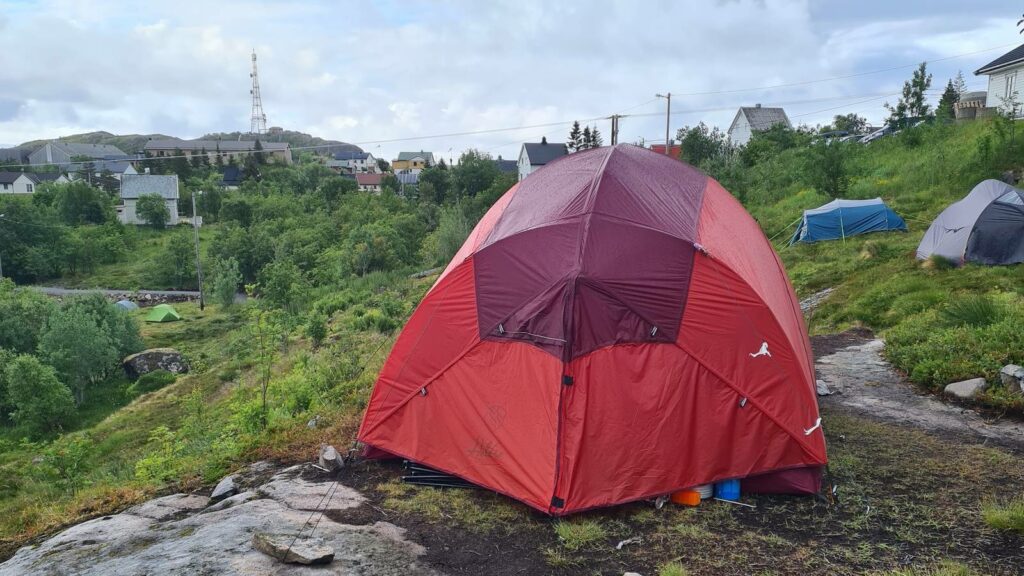
Here’s a guide to what the rules for wild camping in Lofoten are, how they differ from the general regulations in Norway, as well as tips for planning your camping trip to Lofoten in a responsible way.
GUIDE TO WILD CAMPING IN THE LOFOTEN ISLANDS
Here are some content shortcuts to help you navigate this “Guide to Wild Camping in Lofoten.”
1. WHAT IS ALLEMANNSRETTEN
“Allemannsretten” is a Norwegian term that translates to “the everyman’s right” or “the right to roam.” It is a legal concept that gives everyone the right to access and use the Norwegian countryside and nature regardless of who owns the land.
This means that people are allowed to walk, cycle, ski, camp, pick berries and mushrooms in most areas, as long as they do so responsibly and with respect for the environment, local people and the rights of landowners.
Allemannsretten is enshrined in the Norwegian Outdoor Recreation Act of 1957 and is considered an important part of the Norwegian cultural heritage. It is a unique right that is not common in many other countries, and it reflects the importance of nature and outdoor recreation in Norwegian culture.
2. WHAT IS Motorferdselloven
Motorferdselloven, or the Act on Motor Traffic in Uncultivated Land and Waterways, is a Norwegian law designed to protect nature by controlling where and how motor vehicles can be used in uncultivated areas like forests, mountains, and coastal regions.
That means that you cannot drive your motorhome into uncultivated land to camp or park without a specific permit. This means staying on designated roads and parking areas.
IMPORTANT:
We will elaborate a bit more on this because we noticed that many people are not aware of the Motorferdselloven and do not realize they are parking or camping illegally. Basically, you are not allowed to drive anywhere outside of the designated roads.
On our FB page, we published a few pictures from the local newspapers showing people parked illegally in Lofoten, and we received many questions about what is wrong with these pictures.
So, here’s the explanation.
1️⃣ The fact that there are cars already parked in an area does not give you the right to park there as well. Just because someone else is breaking the rules doesn’t mean it is okay for you to do the same.
2️⃣ If it looks like there are tracks leading to your camp spot, it still doesn’t mean it is legal. Most likely, it was some camper before you who made those tracks. The best thing to do is to check Google Maps. Do Google Maps show a road on the map? Yes? Then you might be okay. No? Then you should not be there.

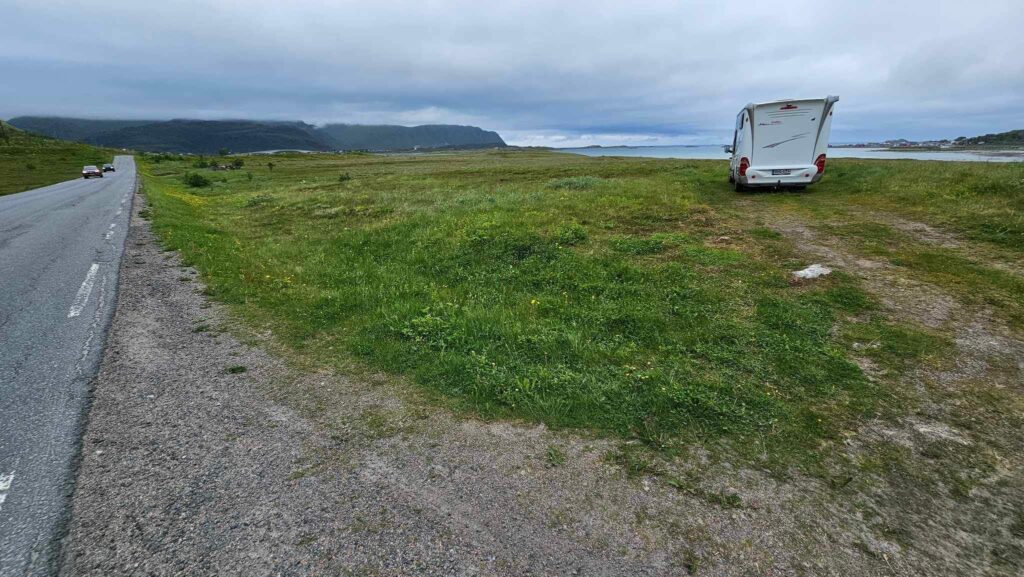

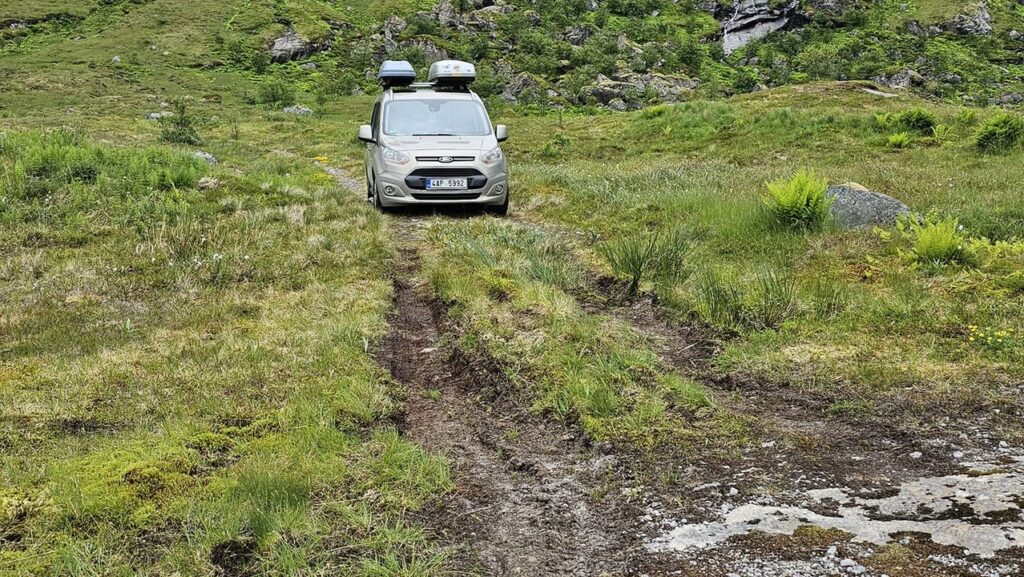
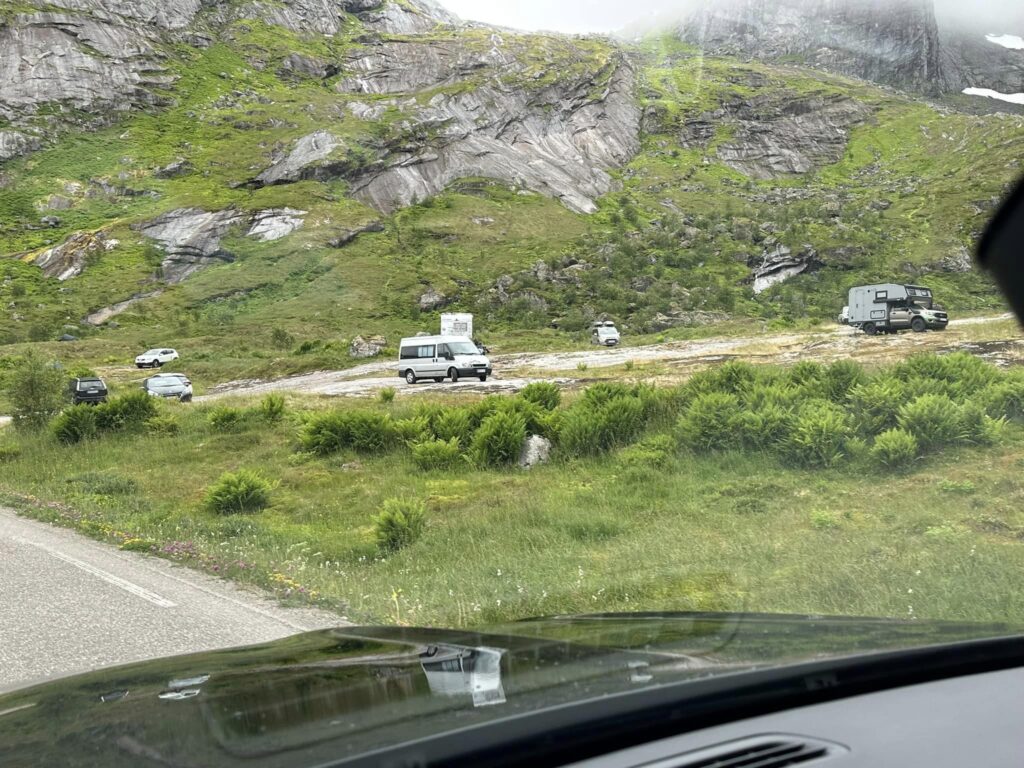
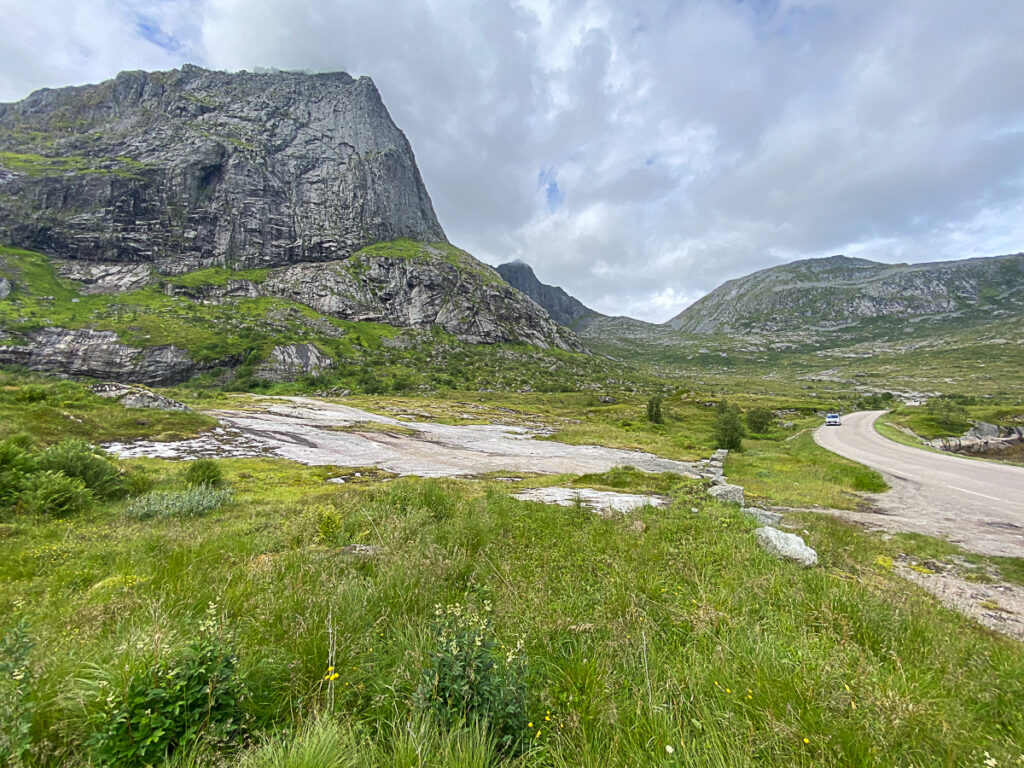
Lofoten Outdoor Council has released a digital tourist map. It highlights the locations of restricted camping zones.
2. General rules for Wild Camping in Norway
In Norway, wild camping is allowed under the “Allemannsretten.” However, there are rules that campers must follow to ensure that they do not harm the environment and respect the rights of landowners and the locals.
Here are some of the most important rules for camping in Norway:
1️⃣ You can camp in the countryside as long as you are at least 150 meters away from the nearest inhabited house or cabin.
2️⃣ Do not camp on cultivated land. In Norway, cultivated land refers to areas used for agriculture, including fields, pastures, and orchards, where the right to roam (allemannsretten) does not apply, and public access is restricted to protect farming activities.
3️⃣ Stay no more than two nights in one place.
4️⃣ Do not leave any waste or litter behind. Bring your trash with you and dispose of it properly.
5️⃣ Use a gas stove or a camping stove instead of making a fire.
6️⃣ Respect the privacy and property of others. Do not camp less than 150m to other people’s homes and cabins, do not block the trailheads and do not disturb the wildlife.
7️⃣ Do not not park your car on the side of the road where it might cause any trouble. See the picture below.
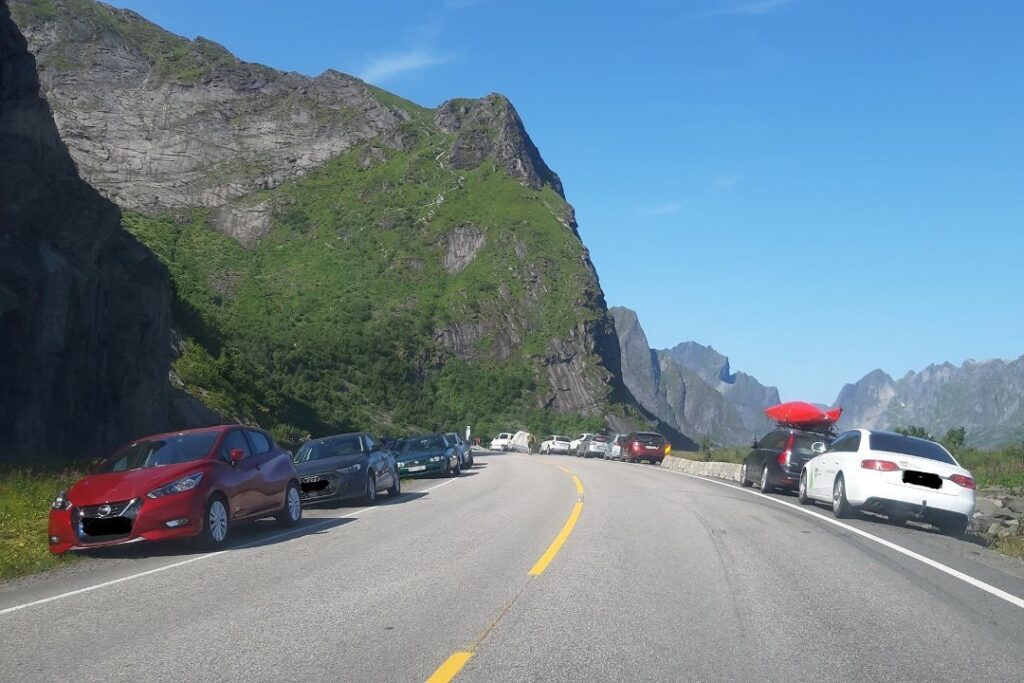
3. Why is there a need to limit Wild Camping in Lofoten?
Wild camping is a great way to experience nature. And we want people to enjoy camping in Lofoten, but it’s essential to be mindful of where and how you set up camp.
With the growing number of tourists visiting Lofoten each year, our fragile ecosystem can’t handle everyone camping at the same spot every day throughout the summer.
And let’s be honest; no one wants to see hundreds of people using the same area as a bathroom, which is precisely what happens in some popular wild camping places like Kvalvika Beach.
We extend a warm welcome to all visitors to Lofoten. However, the increasing number of visitors to Lofoten has brought about specific challenges, such as people camping in inappropriate areas like local gardens, the cemetery, and outdoor recreational areas.
Unfortunately, campers often leave behind trash and human waste in these areas.
We acknowledge that most campers are responsible and respectful towards nature and their surroundings. However, the actions of a few individuals had led to issues that required regulation.
Here are a few examples to illustrate the frustration of local people.
Kai Odd no longer grows strawberries in his garden
In Norway, it’s less common for people to have fences around their gardens than it might be in other countries.
This is partly because Norwegians generally value openness and trust. Additionally, Norway has a long tradition of Allemannsretten.
That means that people can access and use nature for recreational purposes, which may include walking through private property.
As a result, there is often a sense of shared ownership and responsibility for the land. And it’s why people often do not put up a fence to mark off one’s property.
Kai Odd Lorentzen has a garden along the main road E10 with no fence. Sadly it means that people often use his garden as a public toilet.
“Today, I once again saw a tourist defecating in my garden. It’s not the first time, and it is not just in my garden, but also at neighbors ‘, says Lorentzen. “I don’t feel like picking those currants. I’ve also had to shut down my strawberry fields. I lost my appetite.”

Laila had to ask tourists not to camp in the local cemetery
The right to roam and camp generally applies to camping in the wilderness as it provides an opportunity to connect with nature.
However, camping in villages and towns, particularly in football fields or cemeteries, is absolutely unacceptable.
“I think it’s disrespectful. It’s simply rude,” says Tore Holmen to NRK. He lives in Lofoten and is one of those who has experienced tourists taking a little too much liberty.
The other day, when he visited his father’s grave in the cemetery at Reine, Tore noticed two tents set up in the cemetery. “It should be unnecessary to have a ‘camping forbidden’ sign in a cemetery,” he says.
When Laila Jusnes Kristiansen saw other tourists camping in the cemetery in Reine, she decided to confront them.
“I asked if they were aware that they were in a cemetery. The answer I got was, ‘So?’ There was no apology. Instead, they seemed to think that I was the rude one,” Kristiansen said in frustration.
“They didn’t see any problem with it and claimed it was common to camp in such places in France and Spain.”
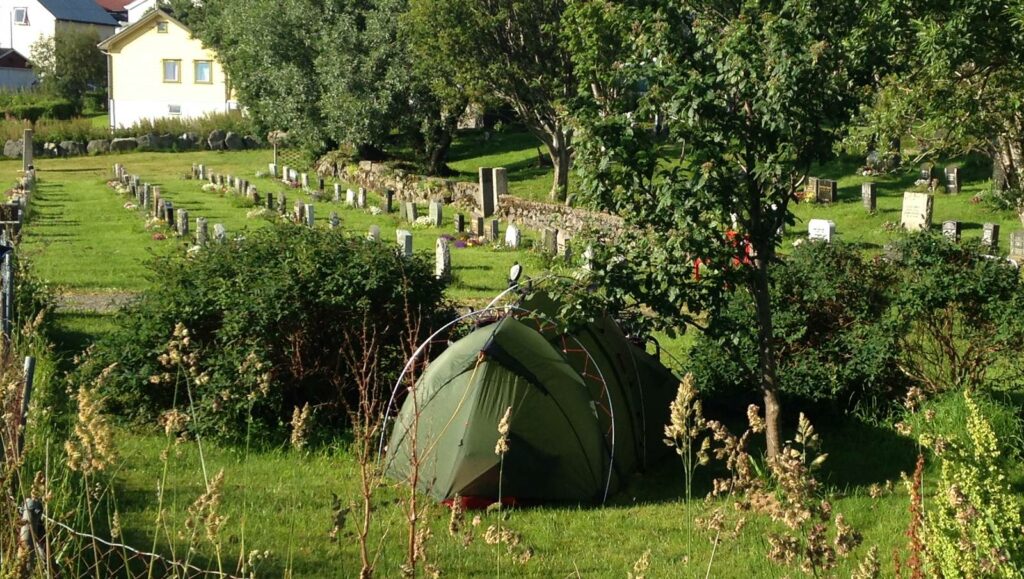
Ragnhild was shocked over a campervan blocking a fire station
In Norway, Allemansretten applies not only to camping in tents but also spending a night in a camper or an RV. So, if you want to camp in your car in a natural area outside of designated campsites, you have to follow the rules set out in the Outdoor Recreation Act.
That means you are allowed to spend a night in your car in uncultivated land for up to 2 days as long as you are at least 150 meters away from the nearest inhabited house or cabin and do not cause any damage or disturbance to the environment.
Imagine the shock of The Chief Fire Officer in Lofoten, Ragnhild Sæbø, when she saw an RV parked right in front of the gate of the fire station.
“I have now seen many cars parked illegally along the road, but parking in front of the fire station gate is something I have never experienced in my 25-year career. If the alarm had gone off, the fire trucks would not have been able to get out,” she states.
Sæbø urges drivers to read the signs carefully and use common sense so they do not end up blocking emergency exits.
For instance, what may appear to be a convenient parking spot near Eliassen Rorbuer on Hamnøy Island is, in reality, a heliport.
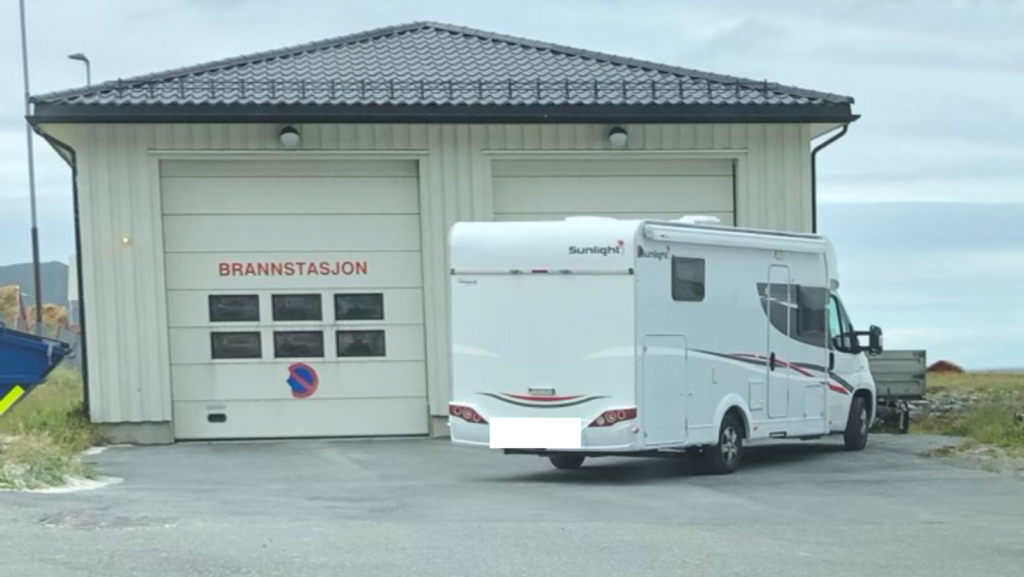
4. New Camping Regulations in Lofoten (2021)
Until 2020, wild camping was allowed anywhere on the Lofoten islands, within the framework of “allemannsretten,” just like in the rest of Norway.
However, in 2020 the six municipalities in Lofoten came together to establish new regional regulations prohibiting camping in certain areas.
Peter Andresen, managing director of Lofoten Outdoor Council, explains that the aim is not to limit the freedom to roam but to preserve Lofoten.
“We would preferably not want to have a ban on camping. However, the need to take some measures has become too significant,” he says.
Andresen also stated that the reason behind the restrictions is to maintain these areas in a manner that provides a pleasant experience for tourists AND residents.
Digital map showing prohibited camping areas
🟢 To help you see the areas where wild camping is prohibited, the Lofoten Outdoor Council has released a digital tourist map. It highlights the locations of toilets, trash cans, and restricted camping zones. The green zones on the map mark the Lofotodden National Park.
🟠 According to Allemansretten, camping is NOT permitted within 150 meters of the nearest house or cabin. The map shows these areas as orange zones.
🔴 The red areas are the newly established no-camping zones.
Please note that the map does not differentiate between cultivated and uncultivated land. Camping is generally not allowed on cultivated land in Norway, even if the campsite is more than 150 meters from the nearest house or cabin.
❗If you need more clarification about whether an area is suitable for camping, it’s always a good idea to ask the locals. Most of us are friendly and happy to help. However, it’s also essential to be prepared to respect their answer.
❗ If you accidentally camp in an area where it’s not allowed and you’re called out on it by locals, the best course of action is to apologize and make plans to pack up and move along.
Areas in Lofoten where wild camping is Newly forbidden (or frowned upon)
Upon announcing the new rules, there was a misconception that wild camping would be entirely prohibited in Lofoten.
However, the newly restricted areas are limited and mainly focus on locations where over-tourism has been a significant issue.
Some of these locations include:
❌ The end of the E10 road in Å
❌ The recreational area around Sørvågvatnet Lake*
❌ Reinebringen
❌ The surroundings of the villages in Reinefjorden
❌ Haukland Beach
❌ Rørvika Beach close to Henningsvær
❌ Kallebukta in Hopen
* According to the Digital map from Lofoten Outdoor Council, the northern part of Sørvågvatnet lake is not in the no camping zone. However, it is a very popular outdoor recreational area for local people and they are upset about people camping there. Please, use the campsite in Moskenes, instead of pitching your tent around Sørvågvatnet.
5. The reality of wild camping in Lofoten
While wild camping is allowed almost anywhere in Lofoten (with the few previously mentioned exceptions), finding a good place to pitch a tent can be difficult due to the terrain.
The land is often not flat. And if it is flat, it’s usually not dry enough for camping.
Moreover, especially in the western part of Lofoten, the E10 road runs along the shoreline, with the ocean on one side and a mountain face on the other. This makes it challenging to find a suitable camping spot along the road.
Finally, even when you venture further into the mountains of Lofoten, you need to understand that some lakes are the drinking water source for nearby villages. As a result, camping is not allowed in these areas to protect the water quality.
NOTE:
Once you pass the Akkarvikkoden rest area and enter the Reinefjorden from the east, you won’t find almost any suitable wild camping places in the vicinity of the road between Hamnøy and Å.
Therefore, your best option in this part of Lofoten is to stay at the campsite in Moskenes, right next to the Moskenes-Bodø ferry terminal. The camp has a place for about 100 campers and many tents. However, in the peak summer season, it can get full.
If that happens, the nearest campsite is Lofoten Beach Camp in Flakstad.
6. Where and WHEN is it allowed to wild camp in Lofoten?
Lofoten’s sandy north-facing beaches like Kvalvika or Bunes are some of Norway’s most beautiful and unspoiled places. This makes them a popular camping destination for nature lovers and photographers.
Even though the two beaches mentioned above lie in the Lofotodden National Park, camping is allowed there as long as campers stick to the guidelines of the “freedom to roam” and “leave no trace” principles.
Wild Camping on Kvalvika Beach
Kvalvika is a beautiful sandy beach located near the village of Fredvang, which has recently gained popularity among tourists. It is often mentioned as one of the best hikes in Lofoten. Therefore, it can not come as a surprise that it can get crowded there during the peak season.
As we mentioned earlier, wild camping is allowed at Kvalvika Beach. Especially in July, many people spend the night on the grassy dunes overlooking the beach and watching the midnight sun.
However, there are no facilities at the beach. Although a stream is coming down on the right side of the beach, next to the trail to Ryten, we strongly advise you against drinking water from there.
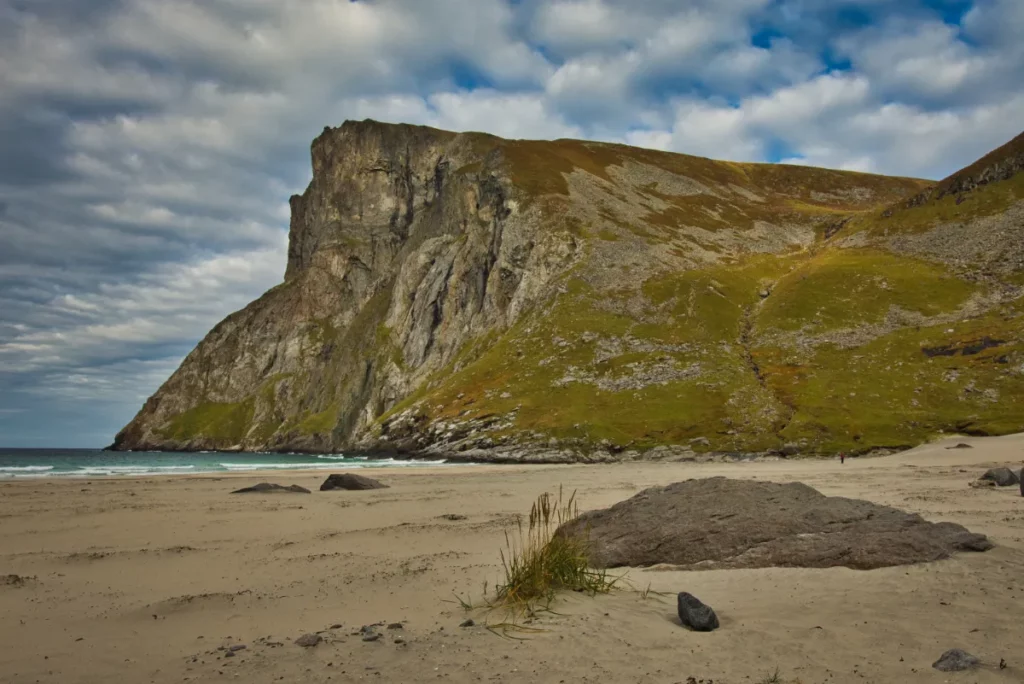
NOTE:
The shortest path to Kvalvika starts in Torsfjorden. However, the parking place there has only space for about 8 cars, and people often park illegally along the narrow road creating traffic chaos. Therefore, we recommend using the (paid) parking place in Innersand and hiking to Kvalvika from there.
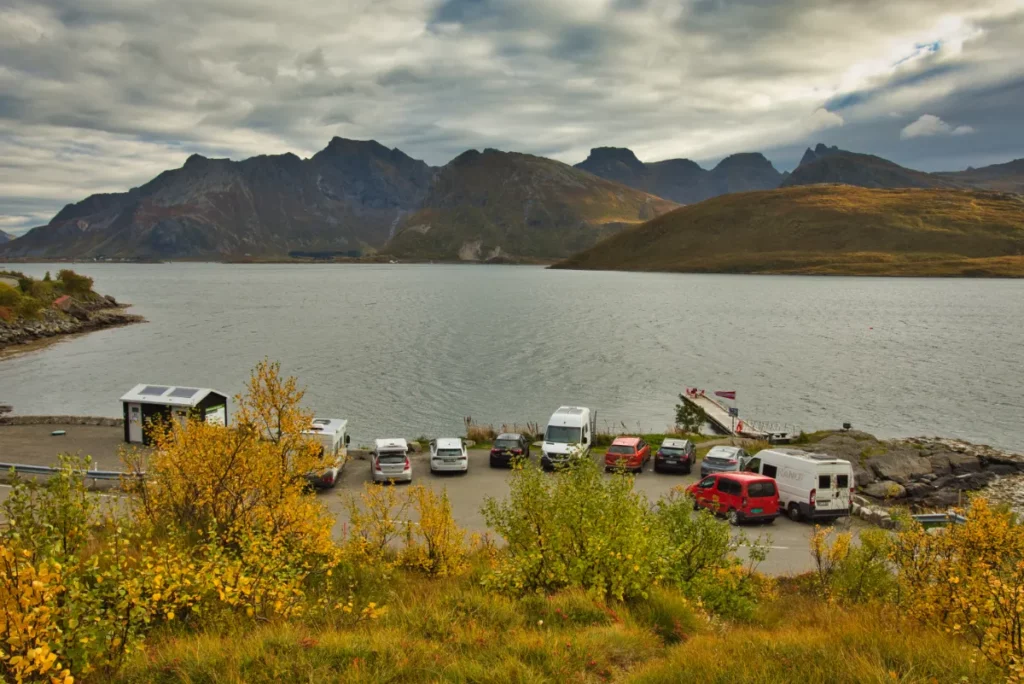
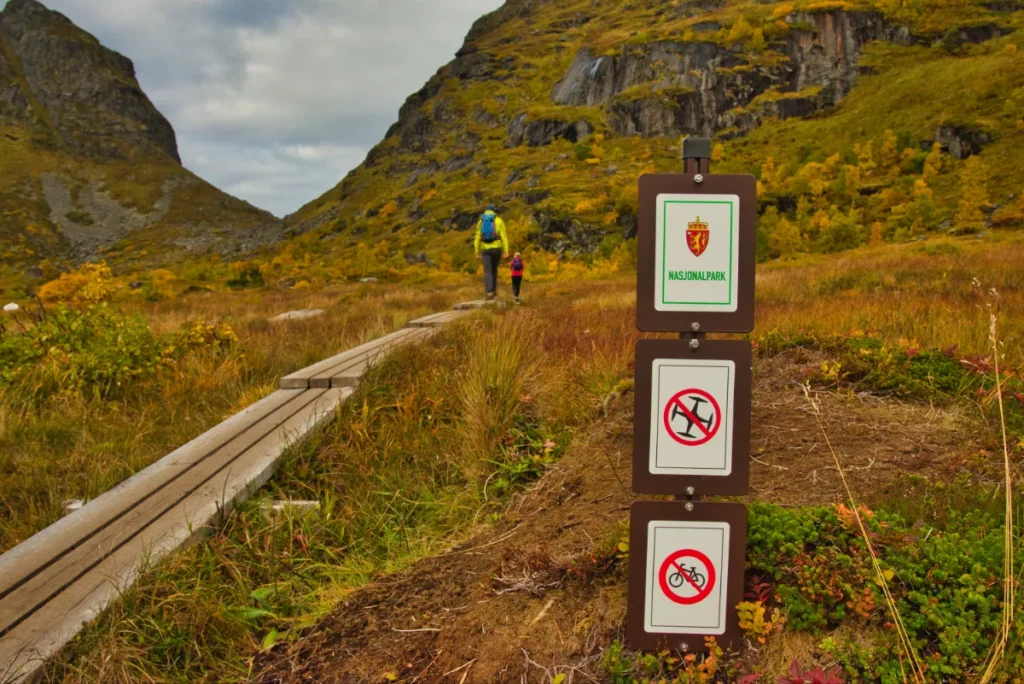
Why you should not drink water on Kvalvika Beach
A study was carried out by Norwegian researchers from NINA in 2021 to map the areas along the path and beach, where human and animal feces were found, and to assess the levels of E.coli bacteria in the streams at Kvalvika beach.
The water samples collected in August 2021 showed relatively high levels of E.coli bacteria in two out of three of the streams where samples were taken.

How should one manage human waste while camping?
Regarding wild camping, it is essential to remember that leaving no trace goes beyond just picking up your trash. Proper disposal of human waste is also crucial to preserve the natural environment.
We asked Ole-Jakob Kvalshaug, the park warden of Lofotodden National Park, what the guidelines are for depositing human waste on Kvalvika.
“Burying human waste may seem like a viable option, but I would not recommend it in areas with high visitor numbers,” Ole-Jakob says. This is because the waste can take a long time to decompose and pollute the environment. Sand is also not an ideal substrate for decomposition.
Instead, Ole-Jakob recommends packing out all solid human waste and disposing of it properly in designated waste facilities: “The visitor center for Lofotodden has started to stock up on WAG bags, and we are thinking of making a simple poop guide for visitors who wonder what to do with their business.”

What is a WAG bag?
A WAG bag is a portable toilet kit containing a bag containing a powder that gels liquids, a zip-close disposal bag, and toilet paper. When you’re finished using the WAG bag, seal it up, and pack it with your other trash. The WAG bags are commonly used for human waste disposal in areas where traditional toilets are not available or appropriate, such as in wilderness areas, or big wall climbing.
7. How should you practice "Leave no Trace" in Lofoten?
Leave No Trace offers a set of seven principles that provide a clear and straightforward framework for anyone who wants to minimize their impact on the environment when enjoying the great outdoors.
#1 Plan Ahead and Prepare
Proper planning helps ensure you have the right skills, equipment, and information for your trip. It also helps reduce resource damage and avoidable impacts.
How can you adapt it for planning a trip to Lofoten?
1️⃣ Do your research!
We try to answer people’s questions about traveling to Lofoten in our Lofoten&Tromsø: Trip Planning FB Group.
In addition, we have created several interactive maps of Lofoten, which include described hiking trails, free camping spots, campsites, information on public toilets and chemical WC disposal stations, and much other helpful information.
2️⃣ Talk to the locals!
Feel free to ask, be it about wild camping spots or the difficulty of your planned hike. Most locals are nice and friendly people and will be willing to help.
#2 Travel and Camp on Durable Surfaces
Stay on established trails and campsites to avoid damaging sensitive ecosystems. Use designated campsites, rock, gravel, dry grasses, or snow to camp on.
How can you adapt it traveling around in Lofoten?
🥾 Bring proper hiking shoes and equipment!
The trails in Lofoten are often muddy, but rather than creating new routes and causing erosion of the mountains, bring tall waterproof hiking boots and stick to the established path. This is especially important on the trail to Ryten and Munkebu.
🚙 Do Not Drive Off the Road
Remember that off-road driving is forbidden in Norway according to the Motorferdselloven. You are allowed to park or camp in designated parking places, road shoulders, and paved surfaces as long as you are not violating the right to roam (allemannsretten) or if there are no signs prohibiting it. However, do not drive onto soft surfaces such as grassland, fields, or farmland etc.
#3 Dispose of Waste Properly
Pack it in, pack it out. Carry out all trash, leftover food, and litter. Use established facilities when available. Properly dispose of human waste and toilet paper.
How can you adapt it traveling around in Lofoten?
🚽 Use a public toilet whenever you can! Are you planning a hiking trip to the mountains? Start with using a restroom before you go.
💩 Stock up on WAG bags! A WAG bag is a portable toilet kit containing a bag containing a powder that gels liquids, a zip-close disposal bag, and toilet paper. They sell them in the Ramberg tourist shop and the Lofotodden visitor center in Reine.
💩 Did you forget to buy WAG bags? Carry a compact camping trowel and use it to dig a hole that is 20-25cm deep before doing your business. You can also use a tent peg instead of a shovel.
💩 Bring a ZIP lock bag. OK, the whole thing about not leaving human waste in nature is still very new to many, so at least find a spot away from the trail or at least 50 meters away from a water source to do your business. Afterward, pack your used toilet paper or wet wipes into the zip lock bag and bring it back to the civilization for proper disposal.
#4 Leave What You Find
Leave rocks, plants, archaeological artiffacts, and other objects as you find them. Do not dig trenches, build structures, or damage vegetation.
How can you adapt it traveling around in Lofoten?
💡 Take Only Pictures, Leave Only Footprints. This does not need any further explanation.
#5 Minimize Campfire Impact
Use a lightweight stove for cooking and enjoy a campfire only where permitted. Use established fire rings, keep fires small, and burn only small sticks and twigs found on the ground.
How can you adapt it for traveling around Lofoten?
🔥 Respect the general fire ban!
The weather is sometimes dry in spring and summer. That means an increased risk of forest and heathland fires. For this reason, there is a general campfire ban in place in Norway from April 15 to September 15.
#6 Respect Wildlife
Observe wildlife from a distance and do not follow or approach them. Store food and trash securely to avoid attracting animals. Do not feed wildlife.
How can you adapt it for traveling around Lofoten?
🦮 Respect båndtvang
“Båndtvang” is a Norwegian term that refers to when dog owners are legally required to keep their dogs on a leash. The general “båndtvang” period in Norway is from April 1 to August 20, although specific dates may vary depending on the municipality.
We recommend you keep your dog on a leash all year round as the municipalities in Lofoten have different rules and some of them have require you to have your dog on leash all year round. Sheep farming is a common practice in the Lofoten Islands, and the sheep do graze outdoors for much of the year.
🚁 Respect drone rules
In Lofoten, you cannot fly drones within the Lofotodden National Park. Unfortunately, that includes the popular hikes to Kvalvika Beach, Ryten, Bunes Beach, and Horseid Beach. Do not harass or disturb birds and other wildlife by drone flights, no matter if you are in a national park or not.
👉 Check the rules for drone flying in Lofoten & Norway.

#7 Be Considerate of Other Visitors
Respect other visitors and protect the quality of their experience. Be courteous and yield to other hikers on the trail. Keep noise levels down, leave radios and electronic devices at home, or use headphones.
How can you adapt it for traveling around Lofoten?
🔊 This is pretty self-explanatory. We understand that you are excited to share the view from Reinebringen with your loved ones at home, but not everyone came up to the ridge to listen to your face timing.
👉 Read more about how to hike Reinebringen + where to park legally
8. Wild Camping in Lofoten: Summary and Conclusion
I know that this article was quite long. Still, I wanted to give you an insight into why it was essential to implement certain restrictions on the freedom to roam in Lofoten and to help you understand why local people can get frustrated about the behavior of some visitors.
If you plan to camp in Lofoten:
✅ Please, use designated campsites in Lofoten!
✅ Before pitching your tent outside a designated campsite, make sure that you are not camping in a restricted area.
✅ Even if the map says that you are good, you might still be about to pitch your tent on cultivated land. Talk to the locals and respect their answers.
✅ If you are asked to leave because you camp at a spot where it is not allowed, apologize, pack your stuff, and move on.
✅ Leave no trace. That includes human waste and toilet paper/wet wipes.
Lofoten is a beautiful destination that welcomes tourists from all over the world, including those who want to camp. But let’s face it, with the increasing number of visitors; it is not sustainable to accommodate everyone by wild camping along the road, especially not during the peak summer season.
Camping in the mountains and beaches is still an option if you are well-prepared, responsible, and respectful of local laws and basic wild camping ethics.
By doing so, we can all, visitors AND locals alike, enjoy Lofoten’s beauty while preserving its natural wonders for future generations.
Please leave us a comment below if you have any questions about wild camping in Lofoten or if you want to share your experience, be it from a local or tourist perspective!
MORE RESOURCES ON TRAVELING TO LOFOTEN

Ivar & Radka
Hi! We are Ivar & Radka, an international couple who runs the Guide to Lofoten. We met in Trondheim and lived together in western Norway, Narvik and Tromsø. At the moment we call western Lofoten our home. We hope our page will make it easier for you to explore the beautiful places that made us chose Norway for our home.
WILD CAMPING GUIDE TO LOFOTEN: PiN IT!
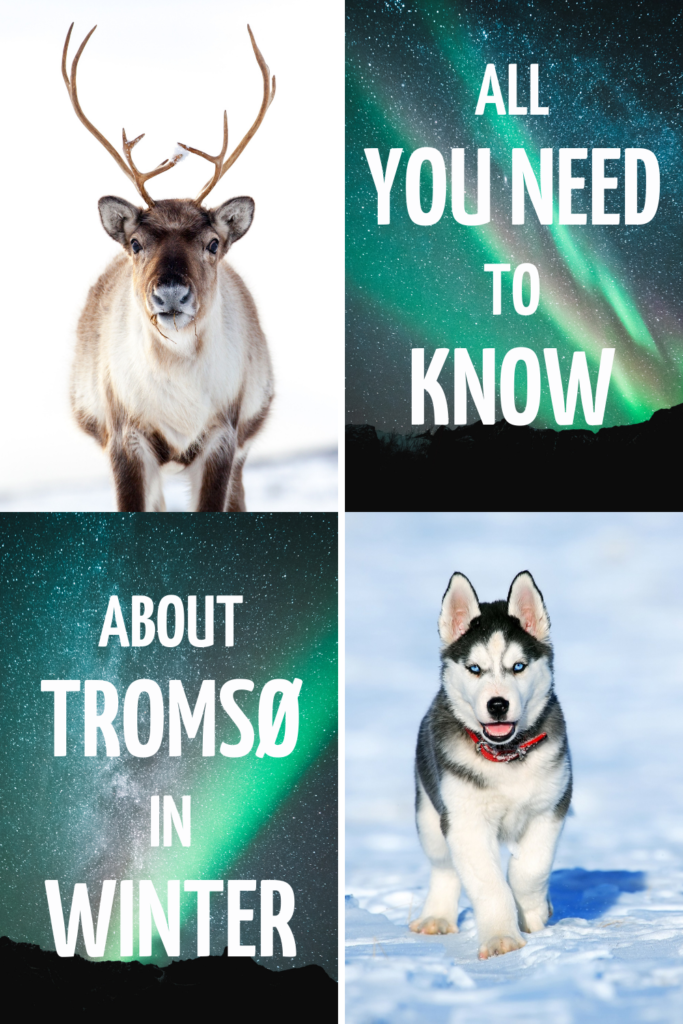
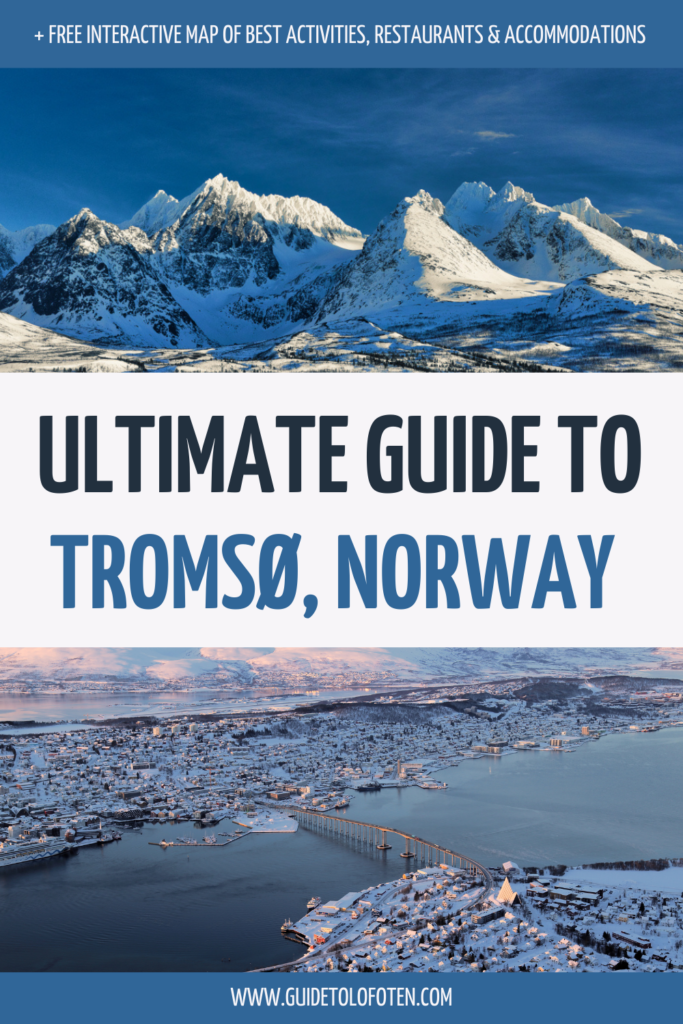
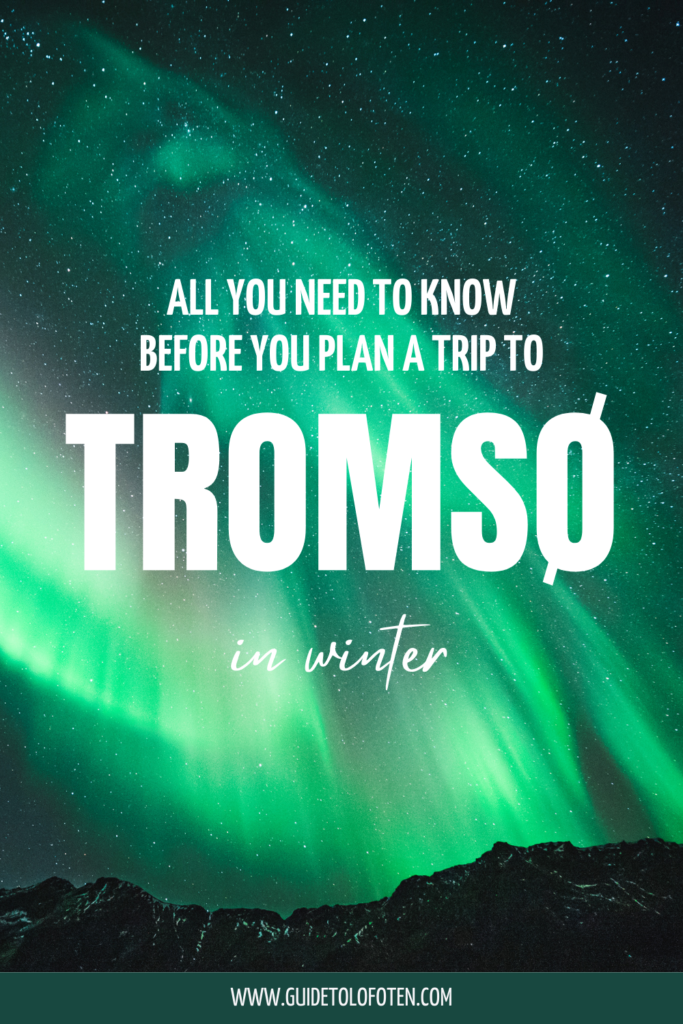






4 Responses
Hi!
Quoted Camping Maps link takes to landing page, but need login credentials… But no create account etc… How do I can access these maps?
Hi there, we decided to stop selling the camping map due to increasing friction with the locals and more and more restrictions. Honestly, there is not many places left where it would be possible to park overnight without breaking the rules.
Hola Ivar & Radka, my wife and I are planning a trip to Norway and to spend a week in Lofoten hiking and enjoying nature. can you help us with or direct us to find information for public transportation. We want to use it instead of renting a car. We enjoy walking an nature. Also after reading your articles and others we are thinking about staying at a central place (hopefully economic) close to or near public transportation and or trail heads to the main and popular hikes in Lofoten. We leave in the USA but were born in Mexico and Colombia; our trip will be 2nd and 3rd week of June 2025. We will await for your responses and guidance. Muchas Gracias.
martini1990@att.net . Martin and Monica Gonzalez
Hi Ivar & Radka,
first of all, thanks a lot for all the information of your blog and I’m glad to see that you have interactive maps that can be bought to pay back all the effort you put on it. I’m retting a camper with my partner to visit lofoten in October since I like the freedom that it provides, but at the same time we’re very conscious about the impact on local people of camping as you explained in the “wildcamping in loftosen” entry. One suggestion I have is that you may also put examples of where it’s fine to park, as it may be straight forward for you but maybe not for foreigners used to other regulations (I’m from Spain and here you can park in any public track as long as you don’t block the path, but you can not camp). Can you for example park on the side of the road when there’s plenty of room and don’t affect traffic (no like the picture that you showed of the trailhead to Reinebringen)?
If it’s not too much to ask, can I ask your thinking regarding renting an EV campervan to visit lofoten. The intention is to reduce the carbon footprint, but I’m a bit worried about charging stations in remote locations.
Thanks a lot,
Daniel